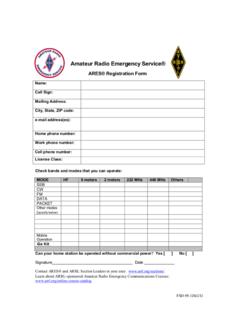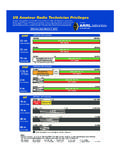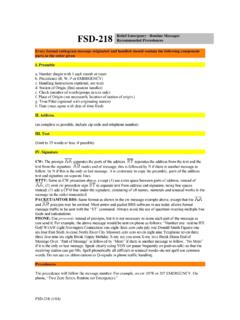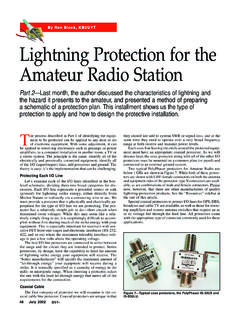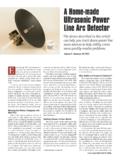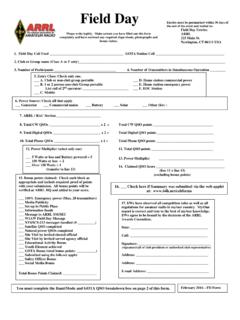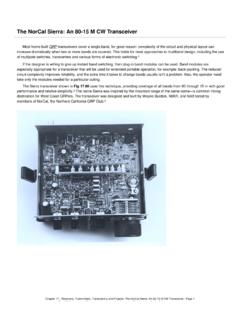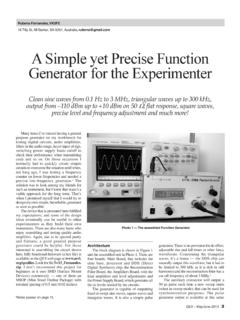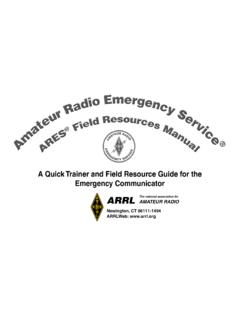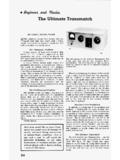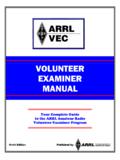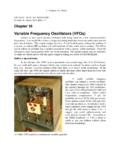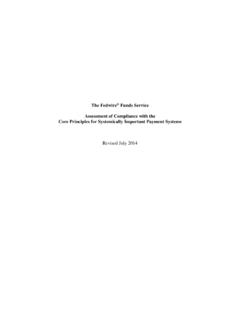Transcription of Study Guide for Exam Questions - American Radio …
1 question Pool 1 Study Guidefor Exam Questions Study Guide for Exam QuestionsThis version of the question Pool has been rearranged to follow the topics as presented in the ARRL General Class License Manual. See the printed book for a version of the question Pool arranged by Subelement as released by the NCVEC question Pool you Study , cover the answer key provided at the margin to test your knowledge. (Please note: Answer selections may be presented in a different order on the actual exam.)Chapter 2 Section choosing a transmitting frequency, what should you do to comply with good amateur practice?A. Review FCC Part 97 Rules regarding permitted frequencies and emissionsB. Follow generally accepted band plans agreed to by the Amateur Radio Before transmitting, listen to avoid interfering with ongoing communicationD. All of these choices are correctG2A01 Which sideband is most commonly used for voice communications on frequencies of 14 MHz or higher?
2 A. Upper sidebandB. Lower sidebandC. Vestigial sidebandD. Double sidebandG1B08 (D) Page 2-3G2A01 (A) Page 2-72 question PoolG2A02 Which of the following modes is most commonly used for voice communications on the 160, 75, and 40 meter bands?A. Upper sidebandB. Lower sidebandC. Vestigial sidebandD. Double sidebandG2A03 Which of the following is most commonly used for SSB voice communications in the VHF and UHF bands?A. Upper sidebandB. Lower sidebandC. Vestigial sidebandD. Double sidebandG2A04 Which mode is most commonly used for voice communications on the 17 and 12 meter bands?A. Upper sideband B. Lower sidebandC. Vestigial sidebandD. Double sidebandG2A05 Which mode of voice communication is most commonly used on the high frequency amateur bands? A. Frequency modulation B. Double sideband C. Single sideband D. Phase modulation G2A06 Which of the following is an advantage when using single sideband as compared to other analog voice modes on the HF amateur bands?
3 A. Very high fidelity voice modulation B. Less bandwidth used and higher power efficiency C. Ease of tuning on receive and immunity to impulse noiseD. Less subject to static crashes (atmospherics)G2A07 Which of the following statements is true of the single sideband (SSB) voice mode? A. Only one sideband and the carrier are transmitted; the other sideband is suppressedB. Only one sideband is transmitted; the other sideband and carrier are suppressed C. SSB voice transmissions have higher average power than any other modeD. SSB is the only mode that is authorized on the 160, 75 and 40 meter amateur bands G2A02 (B) Page 2-7G2A03 (A) Page 2-7G2A04 (A) Page 2-7G2A05 (C) Page 2-7G2A06 (B) Page 2-7G2A07 (B) Page 2-7 question Pool 3G2A08 Which of the following is a recommended way to break into a conversation when using phone?A. Say QRZ several times followed by your call signB.
4 Say your call sign during a break between transmissions from the other stationsC. Say Break. Break. Break. and wait for a responseD. Say CQ followed by the call sign of either stationG2A09 Why do most amateur stations use lower sideband on the 160, 75 and 40 meter bands?A. Lower sideband is more efficient than upper sideband at these frequenciesB. Lower sideband is the only sideband legal on these frequency bandsC. Because it is fully compatible with an AM detectorD. Current amateur practice is to use lower sideband on these frequency bandsG2A10 Which of the following statements is true of SSB VOX operation?A. The received signal is more natural soundingB. VOX allows hands free operationC. Frequency spectrum is conservedD. Provides more power outputG2A11 What does the expression CQ DX usually indicate?A. A general call for any stationB.
5 The caller is listening for a station in Germany C. The caller is looking for any station outside their own countryD. A distress callG2B01 Which of the following is true concerning access to frequencies?A. Nets always have priorityB. QSO s in process always have priorityC. No one has priority access to frequencies, common courtesy should be a guideD. Contest operations must always yield to non-contest use of frequenciesG2B03If propagation changes during your contact and you notice increasing interference from other activity on the same frequency, what should you do?A. Tell the interfering stations to change frequency B. Report the interference to your local Amateur Auxiliary Coordinator C. As a common courtesy, move your contact to another frequency D. Increase power to overcome interferenceG2A08 (B) Page 2-2G2A09 (D) Page 2-7G2A10 (B) Page 2-10G2A11 (C) Page 2-2G2B01 (C) Page 2-3G2B03 (C) Page 2-64 question PoolG2B04 When selecting a CW transmitting frequency, what minimum frequency separation should you allow in order to minimize interference to stations on adjacent frequencies?
6 A. 5 to 50 Hz B. 150 to 500 Hz C. 1 to 3 kHz D. 3 to 6 kHz G2B05 What is the customary minimum frequency separation between SSB signals under normal conditions?A. Between 150 and 500 Hz B. Approximately 3 kHz C. Approximately 6 kHz D. Approximately 10 kHz G2B06 What is a practical way to avoid harmful interference when selecting a frequency to call CQ on CW or phone?A. Send QRL? on CW, followed by your call sign; or, if using phone, ask if the frequency is in use, followed by your call signB. Listen for 2 minutes before calling CQ C. Send the letter V in Morse code several times and listen for a responseD. Send QSY on CW or if using phone, announce the frequency is in use , then send your call and listen for a responseG2B07 Which of the following complies with good amateur practice when choosing a frequency on which to initiate a call?
7 A. Check to see if the channel is assigned to another stationB. Identify your station by transmitting your call sign at least 3 timesC. Follow the voluntary band plan for the operating mode you intend to useD. All of these choices are correctG2B08 What is the DX window in a voluntary band plan?A. A portion of the band that should not be used for contacts between stations within the 48 contiguous United States B. An FCC rule that prohibits contacts between stations within the United States and possessions on that band segment C. An FCC rule that allows only digital contacts in that portion of the band D. A portion of the band that has been voluntarily set aside for digital contacts only G2C01 Which of the following describes full break-in telegraphy (QSK)?A. Breaking stations send the Morse code prosign BKB. Automatic keyers are used to send Morse code instead of hand keysC.
8 An operator must activate a manual send/receive switch before and after every transmissionD. Transmitting stations can receive between code characters and elementsG2B04 (B) Page 2-3G2B05 (B) Page 2-3G2B06 (A) Page 2-3G2B07 (C) Page 2-2G2B08 (A) Page 2-4G2C01 (D) Page 2-12 question Pool 5G2C02 What should you do if a CW station sends QRS ?A. Send slowerB. Change frequencyC. Increase your powerD. Repeat everything twiceG2C03 What does it mean when a CW operator sends KN at the end of a transmission?A. Listening for novice stationsB. Operating full break-inC. Listening only for a specific station or stationsD. Closing station nowG2C04 What does it mean when a CW operator sends CL at the end of a transmission?A. Keep frequency clear B. Operating full break-inC. Listening only for a specific station or stationsD. Closing stationG2C05 What is the best speed to use answering a CQ in Morse Code?
9 A. The fastest speed at which you are comfortable copyingB. The speed at which the CQ was sentC. A slow speed until contact is establishedD. 5 wpm, as all operators licensed to operate CW can copy this speedG2C06 What does the term zero beat mean in CW operation?A. Matching the speed of the transmitting stationB. Operating split to avoid interference on frequencyC. Sending without errorD. Matching your transmit frequency to the frequency of a received sending CW, what does a C mean when added to the RST report?A. Chirpy or unstable signalB. Report was read from S meter reading rather than estimatedC. 100 percent copyD. Key clicksG2C08 What prosign is sent to indicate the end of a formal message when using CW? A. SK B. BK C. ARD. KNG2C02 (A) Page 2-12G2C03 (C) Page 2-12G2C04 (D) Page 2-12G2C05 (B) Page 2-12G2C06 (D) Page 2-12G2C07 (A) Page 2-11G2C08 (C) Page 2-126 question PoolG2C09 What does the Q signal QSL mean?
10 A. Send slowerB. We have already confirmed by cardC. I acknowledge receiptD. We have worked beforeG2C10 What does the Q signal QRQ mean?A. Slow downB. Send fasterC. Zero beat my signalD. Quitting operationG2C11 What does the Q signal QRV mean?A. You are sending too fastB. There is interference on the frequencyC. I am quitting for the dayD. I am ready to receive messagesG2D08 Why do many amateurs keep a log even though the FCC doesn t require it?A. The ITU requires a log of all international contactsB. The ITU requires a log of all international third party trafficC. The log provides evidence of operation needed to renew a license without retest D. To help with a reply if the FCC requests informationG2D09 What information is traditionally contained in a station log?A. Date and time of contactB. Band and/or frequency of the contact C.
